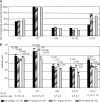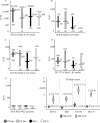Passively transmitted gp41 antibodies in babies born from HIV-1 subtype C-seropositive women: correlation between fine specificity and protection
- PMID: 22301151
- PMCID: PMC3318605
- DOI: 10.1128/JVI.06359-11
Passively transmitted gp41 antibodies in babies born from HIV-1 subtype C-seropositive women: correlation between fine specificity and protection
Abstract
HIV-exposed, uninfected (EUN) babies born to HIV-infected mothers are examples of natural resistance to HIV infection. In this study, we evaluated the titer and neutralizing potential of gp41-specific maternal antibodies and their correlation with HIV transmission in HIV-infected mother-child pairs. Specific gp41-binding and -neutralizing antibodies were determined in a cohort of 74 first-time mother-child pairs, of whom 40 mothers were infected with HIV subtype C. Within the infected mother cohort, 16 babies were born infected and 24 were PCR negative and uninfected at birth (i.e., exposed but uninfected). Thirty-four HIV-uninfected and HIV-unexposed mother-child pairs were included as controls. All HIV-positive mothers and their newborns showed high IgG titers to linear epitopes within the HR1 region and to the membrane-proximal (MPER) domain of gp41; most sera also recognized the disulfide loop immunodominant epitope (IDE). Antibody titers to the gp41 epitopes were significantly lower in nontransmitting mothers (P < 0.01) and in the EUN babies (P < 0.005) than in HIV-positive mother-child pairs. Three domains of gp41, HR1, IDE, and MPER, elicited antibodies that were effectively transmitted to EUN babies. Moreover, in EUN babies, epitopes overlapping the 2F5 epitope (ELDKWAS), but not the 4E10 epitope, were neutralization targets in two out of four viruses tested. Our findings highlight important epitopes in gp41 that appear to be associated with exposure without infection and would be important to consider for vaccine design.
Figures





Similar articles
-
Plasma IgG to linear epitopes in the V2 and V3 regions of HIV-1 gp120 correlate with a reduced risk of infection in the RV144 vaccine efficacy trial.PLoS One. 2013 Sep 26;8(9):e75665. doi: 10.1371/journal.pone.0075665. eCollection 2013. PLoS One. 2013. PMID: 24086607 Free PMC article.
-
Structure and Recognition of a Novel HIV-1 gp120-gp41 Interface Antibody that Caused MPER Exposure through Viral Escape.PLoS Pathog. 2017 Jan 11;13(1):e1006074. doi: 10.1371/journal.ppat.1006074. eCollection 2017 Jan. PLoS Pathog. 2017. PMID: 28076415 Free PMC article.
-
Patterns of immunoglobulin G subclass reactivity to HIV-1 envelope peptides in children born to HIV-1-infected mothers.AIDS. 1992 Apr;6(4):365-71. doi: 10.1097/00002030-199204000-00002. AIDS. 1992. PMID: 1616634
-
Antigp41 membrane proximal external region antibodies and the art of using the membrane for neutralization.Curr Opin HIV AIDS. 2017 May;12(3):250-256. doi: 10.1097/COH.0000000000000364. Curr Opin HIV AIDS. 2017. PMID: 28422789 Review.
-
Neutralizing Antibodies Targeting HIV-1 gp41.Viruses. 2020 Oct 23;12(11):1210. doi: 10.3390/v12111210. Viruses. 2020. PMID: 33114242 Free PMC article. Review.
Cited by
-
The role of neutralizing antibodies in prevention of HIV-1 infection: what can we learn from the mother-to-child transmission context?Retrovirology. 2013 Oct 7;10:103. doi: 10.1186/1742-4690-10-103. Retrovirology. 2013. PMID: 24099103 Free PMC article. Review.
-
Randomized Phase I: Safety, Immunogenicity and Mucosal Antiviral Activity in Young Healthy Women Vaccinated with HIV-1 Gp41 P1 Peptide on Virosomes.PLoS One. 2013;8(2):e55438. doi: 10.1371/journal.pone.0055438. Epub 2013 Feb 20. PLoS One. 2013. PMID: 23437055 Free PMC article. Clinical Trial.
-
The Role of Maternal HIV Envelope-Specific Antibodies and Mother-to-Child Transmission Risk.Front Immunol. 2017 Sep 4;8:1091. doi: 10.3389/fimmu.2017.01091. eCollection 2017. Front Immunol. 2017. PMID: 28928750 Free PMC article. Review.
-
Diazabicyclo analogues of maraviroc: synthesis, modeling, NMR studies and antiviral activity.Medchemcomm. 2016 Dec 16;8(2):422-433. doi: 10.1039/c6md00575f. eCollection 2017 Feb 1. Medchemcomm. 2016. PMID: 30108760 Free PMC article.
-
Diversity and Function of Maternal HIV-1-Specific Antibodies at the Time of Vertical Transmission.J Virol. 2020 Apr 16;94(9):e01594-19. doi: 10.1128/JVI.01594-19. Print 2020 Apr 16. J Virol. 2020. PMID: 32075936 Free PMC article.
References
-
- Alfsen A, Iniguez P, Bouguyon E, Bomsel M. 2001. Secretory IgA specific for a conserved epitope on gp41 envelope glycoprotein inhibits epithelial transcytosis of HIV-1. J. Immunol. 166:6257–6265 - PubMed
-
- Baba TW, et al. 2000. Human neutralizing monoclonal antibodies of the IgG1 subtype protect against mucosal simian-human immunodeficiency virus infection. Nat. Med. 6:200–206 - PubMed
Publication types
MeSH terms
Substances
LinkOut - more resources
Full Text Sources
Other Literature Sources
Medical

